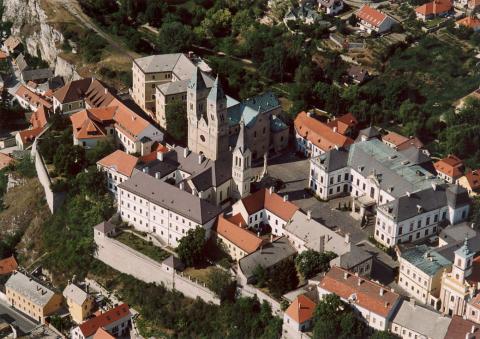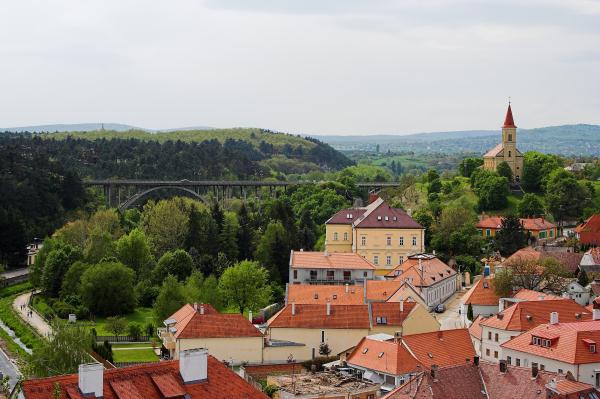Attention! Lot of Muggle! Be patient!
Please hide the cache back exactly as you found it!
Veszprém Castle

Arriving at the square we find ourselves in the heart of the castle. So we should admire the Trinity Statue prepared by Bishop Márton Padányi Bíró in 1750. Among the saints we can see St. Martin, the patron saint of the bishop, St. Stephen, St. Emeric, St. George and Mary Magdalene as well as the family coat of arms of the builder.
Before the Provost Major’s House we can peep down into the forty metre deep Castle Well, which was excavated and renovated in 2002. The cathedral of Veszprém is a perfect example for the town’s fate and history.
To the left we can see the renovated Dubniczay House, next to it the Bíró-Giczey Canon’s House and the Franciscan Church and Friary. (The canon’s houses were named after their builders, who – as members of the church aristocracy – had their houses built in the heart of the episcopal centre.)
The two most important, monumental buildings of the square are the Archbishop’s Palace and St. Michael’s Cathedral. The huge white block of the Archbishop’s Palace bears witness to the wealth and power of the church and the builder, Bishop Ignác Koller. The palace was completed in 1776 based on Jakab Fellner’s design. The foiled corners of the E-shaped building, the tympanum above the balcony with the coat of arms of Bishop Koller, the angels holding the garlands on the pediment and the bastion-like side wings make the building lively. The palace is a gorgeous sight from below the castle as well: the huge back balcony leaning on the castle walls seems to be supporting the whole building. ( From the free car parking.) Some relics from the Árpád period can also be found here. The 13th century Gisella Chapel is hidden between the Baroque Provost Major’s House and the Archbishop’s Palace. Although the town associates it with Queen Gisella, in reality it has nothing to do with our first queen. The originally two-storey chapel was completely destroyed in the Turkish period. Later it was rebuilt several times and it was almost completely demolished when the new Archbishop’s Palace was built. In spite of its condition, its medieval frescoes, cross-vaulted sanctuary and nice keystones offer a memorable sight even today.
Next to the Provost Major’s House, behind the cathedral, in the place of the former small gate of the castle steep stairs wind down towards Benedict Hill and the free car park.
The cathedral of the Veszprém Bishopric – founded first in the country by King Stephen in 996 – was already here, in the northern part of the castle in 1001. The church was founded by Gisella, the first Hungarian queen and since she was its patroness, she helped maintain it with her donations. Afterwards the current Hungarian queen became the patroness of St. Michael’s Cathedral and, owing to this, the Bishop of Veszprém received the right to crown Hungarian queens. This is why Veszprém is called the town of queens. The church, which was originally built in Romanesque style, was destroyed by the troops of Mátél Csák and burnt down in the 14th century. In the Turkish period it shared the fate of the town and was almost completely destroyed in several sieges. It was ravaged during the Rákóczi war of independence and in 1704 General Heister’s soldiers set it on fire. After the stormy life of the cathedral, Bishop Imre Esterházy had it rebuilt. The church, rebuilt in 1723 in Baroque style, was restored almost from ruins and became the first and foremost church of the diocese again. It received its current Neo-Romanesque style during the complete reconstruction of 1910. The medieval remains of the church can be seen on the walls of the southern and northern naves. The three-naved Romanesque-Gothic undercroft, which is the final resting place of several bishops and home to the humerus relic of our first queen – a present from the town of Passau—is open to visitors.
St. George’s Chapel, maybe the oldest medieval building of Veszprém, can be found by the northern side of the cathedral. Although the exact date of building is unknown it must have been built in the 10-11th century. According to St. Emeric’s legend our first king’s son vowed chastity in this originally round chapel. The building was reconstructed in an octagonal shape and gave home to the St. George relic for centuries.
The statue outside the chapel depicts Prince St. Emeric, standing on a dragon – the symbol of impurity defeated – and holding a sword in one hand and a lily in the other. The 18th century Franciscan Church and Friary – today’s St. Francis Old Priests’ Home – is opposite the cathedral. Tejfalussy House, home to Queen Gisella Museumnak, was built in 1772. The museum is a treasure-trove of ecclesiastical art and possesses a rich collection of stones. The building of the Veszprém Committee of the Hungarian Academy of Sciences, the former Dravecz House is juts another 18th century building from the outside, however, it has a nice little garden with a southern atmosphere and an unrivalled view to Jeruzsálem Hill. The last house is the town’s oldest Baroque building, the Körmendy House. The original Rococo/Copf style of the Seminary on the opposite side is only visible in the ornamental gate.

Walk to the northern end of the castle. It is again worth looking around here. Standing next to the 1938 statues of St. Stephen and Blessed Gisella (by József Ispánky) we can have a look at the houses and zigzag streets of the former old town, the double arch of the Valley Bridge to the left, the sometimes barren, sometimes ivied rocks of Benedict Hill to the right and the dark range of the Bakony Hills in the far distance.
Veszprém is the town of winds and bells: legend says that if the wind is not blowing, the bells are ringing. At this point of the town, however, the wind from the Bakony Hills never stops blows. We are standing at the top of a one thousand-year-old castle with a stormy past – with the romantic past of the castle behind us and the 11th century old town in fromt of us: past and present intertwined.
Origin: www.magyarorszag.utazas.hu
